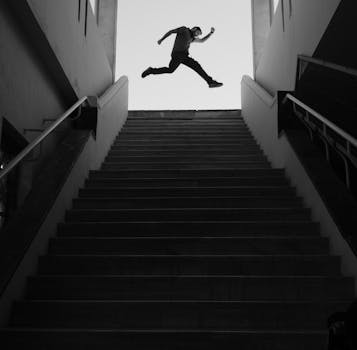Free Running: A Freer and More Expressive Form of Parkour
Free running, often seen as a more artistic and expressive offshoot of parkour, has gained popularity in urban environments around the world. While parkour focuses primarily on efficient movement through obstacles, free running emphasizes creativity, fluidity, and self-expression. This article explores the essence of free running, its techniques, and how individuals can explore their urban surroundings with grace and agility.
The Essence of Free Running
Free running originated in the late 1990s, largely influenced by the parkour movement founded by David Belle in France. However, free running diverges from traditional parkour by incorporating acrobatic elements and a focus on aesthetics. Practitioners, known as free runners, often perform flips, spins, and other gymnastic maneuvers, transforming urban landscapes into dynamic canvases for their art.
Key Differences Between Parkour and Free Running
- Purpose: Parkour is about overcoming obstacles efficiently, while free running prioritizes creativity and self-expression.
- Techniques: Free running includes acrobatics and tricks, whereas parkour focuses on functional movements.
- Mindset: Free runners often view their environment as a playground, encouraging exploration and experimentation.
Exploring the Urban Environment
Urban environments provide a rich tapestry for free runners to explore. From rooftops to alleyways, the city becomes a playground filled with opportunities for movement and creativity. Here are some tips for effectively navigating and exploring urban spaces:
1. Observe Your Surroundings
Before attempting any moves, take time to observe your environment. Look for:
- Potential obstacles like walls, railings, and benches.
- Open spaces for running and landing.
- Safe areas to practice, away from traffic and crowds.
2. Start with Basic Movements
Begin with fundamental techniques to build your confidence and skill level. Some essential movements include:
- Vaults: Overcoming obstacles with a fluid motion.
- Rolls: Reducing impact when landing from heights.
- Precision jumps: Landing accurately on narrow surfaces.
3. Incorporate Acrobatic Elements
As you gain proficiency, start integrating acrobatic moves into your practice. Some popular tricks include:
- Backflips: A classic move that showcases agility.
- Wall flips: Using vertical surfaces to propel yourself into the air.
- Spins: Adding flair to your movements.
Fluidity in Movement
Fluidity is a hallmark of free running. Achieving this requires practice, body awareness, and a deep understanding of movement mechanics. Here are some strategies to enhance your fluidity:
1. Focus on Transitions
Work on transitioning smoothly between different movements. For example, practice moving from a vault directly into a roll, or from a precision jump into a landing. This will help create a seamless flow in your routines.
2. Develop Body Awareness
Understanding your body’s capabilities is crucial. Engage in activities that enhance your proprioception, such as:
- Dancing: Improves rhythm and body control.
- Yoga: Enhances flexibility and balance.
- Martial arts: Builds strength and coordination.
3. Practice Regularly
Consistency is key in mastering free running. Set aside time each week to practice, focusing on different techniques and movements. Document your progress through videos or journals to track improvements and set new goals.
Case Studies and Community Impact
Free running has not only transformed individual lives but has also fostered community engagement. For instance, the “Free Running for Youth” program in London has successfully introduced young people to the sport, promoting physical fitness and self-confidence. According to a study by the University of Kent, participants reported a 30% increase in self-esteem and a 25% improvement in physical fitness after engaging in free running activities.
Conclusion
Free running is more than just a sport; it is a form of self-expression that allows individuals to interact with their urban environments in unique and creative ways. By focusing on fluidity, creativity, and community, free runners can transform ordinary spaces into extraordinary experiences. Whether you are a beginner or an experienced practitioner, embracing the principles of free running can lead to a deeper appreciation of movement and the world around you. So, lace up your shoes, step outside, and let the city inspire your next adventure!
